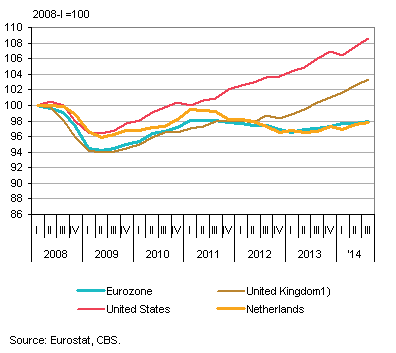modest economic growth in eurozone

According to figures released by Eurostat on Friday, the economies in the eurozone and the EU grew by 0.2 and 0.3 percent respectively in the third quarter compared with the previous quarter. Year-on-year growth was 0.8 percent for the eurozone and 1.3 percent for the EU. Also on Friday, Statistics Netherlands announced a quarter-on-quarter Dutch growth of 0.2 percent and year-on-year growth of 1.1 percent. The Dutch economy has been developing along the same lines as that in the eurozone in the last few years.
Quarter-on-quarter GDP volume changes

Italy and Cyprus have yet to recover
All the eurozone economies grew in the third quarter, except those in Italy and Cyprus. In Italy, the economy shrank in both the second and the third quarter, by 0.2 percent and 0.1 percent respectively, following zero growth in the first quarter. The Italian economy shrank substantially in 2012 in particular. After that the contraction was smaller, but the economy has yet to start growing again. The Cypriot economy has contracted strongly in the last four quarters.
Germany and France growing again
In Germany, the largest economy in the eurozone, quarter-on-quarter growth was 0.1 percent, following a small contraction in the second quarter. Current German economic growth is mainly based on more household spending and higher exports. Investment spending fell though, especially in construction.
France, the second economy in the eurozone, did a little better in the third quarter, with a growth rate of 0.3 percent. The French economy shrank by 0.1 percent in the second quarter, and before that, too, it had hardly grown. Manufacturing production did especially well in the last quarter.
GDP volume index

Stable growth in Spain, Portugal, Belgium and Greece
The Spanish economy has increased in all quarters of 2014; in the third quarter it grew by 0.5 percent. In Greece, too, the economy grew in the first three quarters of 2014. The Portuguese economy showed strong economic growth from the second quarter of 2013, but shrank in the first quarter of 2014, to grow again in the second and third quarters. In Belgium economic growth is modest but stable.
Dutch economy still below level of 2008
Both the Dutch economy and the eurozone economy are below their levels of 2008; both were still 2 percent lower in the third quarter of 2014. The Dutch economy faired better than that of the eurozone for a time, but has not done so now since 2011. Since mid-2012, the economies of the Netherlands and the eurozone have been developing similarly. The German economy - a large factor in the eurozone growth rates - has been recovering strongly since the beginning of 2010. After 2010 German growth, too, decreased, but on average, the German economy has been by far the best performer in the eurozone since the beginning of 2008.
Strong growth for UK economy and further recovery in US
Outside the eurozone, the economy in the United Kingdom grew by 0.7 percent in the third quarter. In the second quarter it had already grown by 0.9 percent. The British economy has been in the stage of strong recovery for more than a year now. In the United States, the largest economy in the world, recovery also continued in the third quarter, with a quarter-on-quarter growth of 0.9 percent. In the second quarter the American economy had already grown by 1.1 percent. It had shrunk in the first quarter, but that was mainly the result of an exceptionally severe winter. Compared with these Anglo-Saxon countries, the Netherlands and the eurozone as a whole are performing very moderately. The US economy is now clearly out of the crisis: third quarter GDP was 8 percent above the level of 2008. The British economy, too, is now well above its 2008 level.
GDP volume index

For the purposes of international comparability, all the growth rates in this article have been adjusted to correct for seasonal and working day effects. The rates for the United Kingdom, marked by 1), have not been adjusted for working day effects.